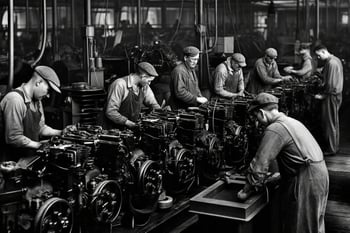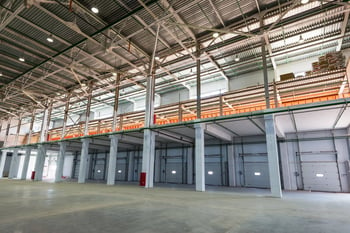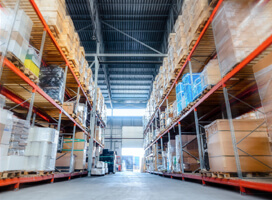
Warehouses seem like a modern-day invention to hold goods before they are ready to be distributed or delivered to customers. But they aren’t that new at all. In fact, humans have been storing supplies for centuries. Here is a brief history of warehousing, including how we got to the modern-day version and its more advanced techniques.
The First Warehouses
Roughly 2,200 years ago, the Romans were well-known for conquering other nations. During this period, they built the Horrea Galbae, which looks a lot like today’s modern warehouses in that it was used to store and retrieve goods.
This first warehouse was actually a large network of buildings located near the Tiber River that covered about 225,000 square feet and contained over 140 separate rooms. It was used to store a massive grain supply for the public, as well as imported goods like wine, olive oil, and clothing.
It was a deliberate decision to build this massive network of warehouses adjacent to the river because Roman ships would show up at the port packed with goods. As the Romans continued to conquer new lands, they would bring home the “spoils” and establish new trade routes for ongoing commerce.
Using “Warehouse” as a Term
The Romans might have invented the warehouse. But they didn’t use the word. The first use of the term “warehouse” can be dated back to Britain in the 1300s. The British defined a warehouse as “a structure or room for the storage of merchandise or commodities."
In the following centuries, England extended its global reach using its durable, fast, and cargo-carrying ships, which would move goods along international trade routes. At the same time, the British established their “warehouses” in ports all over Europe and beyond.
The Industrial Revolution and “Warehousing”
The term “warehouse” was transformed into a verb during the first Industrial Revolution in the late 1700s. At that time, the idea of “warehousing” to improve efficiency became more widespread.
With the rise of mass production using textile and other machines and the availability of steam engines, there was a greater capacity to create goods on a massive level. Those were often held in various warehouses domestically until needed or until they were shipped overseas as part of international commerce.
The Birth of Logistics
The first Industrial Revolution was only the beginning of a massive transformation in the warehouse industry. As railroads began connecting cities and towns throughout North America, this also allowed the logistics industry to grow and flourish.
 Warehouses in certain larger cities were soon used as hubs to store goods for movement to locations further down the line. This greater availability of goods was one of the catalysts for allowing many smaller towns to grow into flourishing cities.
Warehouses in certain larger cities were soon used as hubs to store goods for movement to locations further down the line. This greater availability of goods was one of the catalysts for allowing many smaller towns to grow into flourishing cities.
The Second Industrial Revolution was born in the late 1800s when electricity became available to power the expansion of manufacturing operations. Suddenly, factories and warehouses had access to telephones, light bulbs, and internal combustion engines.
The invention of the automobile was a turning point in commerce and the short-range transportation of goods. One of the first companies to realize the potential for mass commerce was Sears, Roebuck & Co., which built a booming mail-order business. The famous Sears catalog sold thousands of items, with everything from tools to appliances to clothing and even single-family home kits. Much of this merchandise was stored in a massive Chicago distribution center covering 3 million square feet.
Evolution of Warehouse Management and Technology
As warehouses and distribution centers became larger, like the massive one used by Sears (above), there was a need for more organized inventory storage and the order fulfillment process. With Sears, things were still handled by hand for many years, where customers filled out order forms with the items, sizes, and quantities they wanted to purchase through the mail.
New manufacturing methods and industries in the 1900s necessitated the development of better processes and the use of solutions like forklifts, hand trucks, and sophisticated storage racks. Driven by the demands of World War II, manufacturers invented a range of adjustable pallet racking in the 1940s and 1950s.
The technological revolution in warehousing began in the 1970s with the use of the barcode and UPC code. By 1984, about one-third of U.S. grocery stores were using the technology. But it has applications in warehouses as well. In 1975, J.C. Penney installed a warehouse management system (WMS), which gradually became more sophisticated over several decades. By 2004, up to 90% of Fortune 500 companies had digitized using barcodes and a WMS.
The Warehouse of Today and the Future
 Over the past several decades, the warehousing industry has evolved and innovated even more. Improving on the barcode concept, many businesses are now using RFID tags in combination with a WMS.
Over the past several decades, the warehousing industry has evolved and innovated even more. Improving on the barcode concept, many businesses are now using RFID tags in combination with a WMS.
Warehouses are also improving efficiency and productivity by leveraging technology solutions like robotics, wireless computing, wearables, and mobile workstations. In the future, we can expect even more innovation in warehousing and logistics with things like artificial intelligence (AI), the Internet of Things (IoT), big data, machine learning, and advanced analytics.
As you can see, the warehousing concept takes us back centuries. As business owners have continued to work to find cost-effective and efficient ways to store materials and fulfill orders, these systems have evolved into the ones we have today. Technology solutions are ushering in an entirely new revolution in warehouse management. One day, our current era will be viewed as one of the catalysts for future warehouses.












